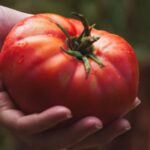Study shows sulfur in soil benefits tomato growth
Some farmers may be negatively affected by reduced sulfur deposits in soil, an unexpected consequence of stricter clean air standards. Adding sulfur could boost yield but about 3%.
Researchers at the University of Florida (UF) have found adding sulfur to soil may increase the yield of tomato crops.
UF Institute of Food and Agricultural Sciences associate professor Bielinski Santos, said adding 25 pounds of elemental sulfur per acre increased yield by about 1.7 tons (MT) compared to a control plot, according to a study published in HortTechnology.
In the study, scientists grew tomatoes on sandy soil, using sulfur amendments ranging from 25 pounds to 200 pounds per acre. Adding sulfur beyond 25 pounds had no additional benefit.
"In general, a 2 to 3% tomato yield increase has been observed in large field operations by adding sulfur at 30 kilograms (66 pounds) per hectare (2.47 acres) once per year when sulfur is deficient," Santos said.
An important nutrient, sulfur normally reaches fields through atmospheric deposition. In recent years however, the amount of sulfur in the atmosphere has been reduced as an unwanted consquence of stricter clean air standards.
Santos recommends adding sulfur to crops as a precaution, stating no field test exists for sulfur content. He said risk of overuse was not a major concern.
"In our studies, adding up to 300 kilograms (661 pounds ) per hectare has not affected tomato growth. Most sulfur-containing sources are very safe as fertilizers. Usually, a rate of 20-30 kilograms (44-66 pounds) per hectare of sulfur will satisfy tomato, pepper and strawberry requirements for a season.
"Sulfur is very inexpensive and there are many sources containing this element. In some of these sources, sulfur can be just an additional compound in the mix. Gypsum (calcium sulfate), elemental sulfur and thiosulfates are examples of commonly found sulfur sources," he said.
The University of Florida research team has conducted a similar study using strawberries. Publication of that research is expected in mid-2013.








































